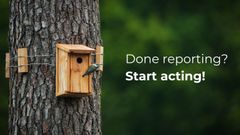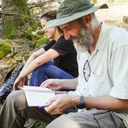Feb 13, 2025
How companies can use reforestation, biodiversity, and carbon projects to improve their CSRD reporting
Discover how investing in reforestation, biodiversity, and carbon projects can strengthen your CSRD reporting. Learn how to integrate ESRS E1, E3, and E4 actions.

You’ve completed your first CSRD report; now what?
The next step is crucial: moving from measurement to action. To improve your second CSRD report, you must demonstrate real, tangible progress in reducing your environmental impact before the 2025 deadline.
Investing in carbon credits, reforestation, and biodiversity projects is one of the most effective ways to take immediate action. Not only do these projects align with the European Sustainability Reporting Standards (ESRS), but they also strengthen your company’s sustainability strategy, enhance transparency, and improve ESG performance.
By integrating nature-based solutions into your business, you’re not just ticking compliance boxes but making a lasting impact on the planet while gaining a competitive advantage. Here’s how you can leverage ESRS E1 (Climate change), E3 (Water & marine Resources), and E4 (Biodiversity & ecosystems) to meet regulatory requirements and drive meaningful environmental change.
Here’s how companies can leverage these projects for compliance, impact, and corporate credibility:
Are you short on time? Jump to the section you’re most interested in reading:
- ESRS E1: Climate change & carbon removal projects
- ESRS E3: Water & marine resources – wetland restoration
- ESRD E4: Biodiversity & ecosystems
Firstly, what is ESRS, and why is it relevant?
The ESRS provides the framework for companies to disclose their sustainability impacts under the CSRD and provides clear guidelines on how businesses should measure, report, and improve their environmental and social sustainability performance.
Companies subject to CSRD must align their reporting with ESRS to ensure transparency and accountability in their environmental actions. The ESRS framework is designed to:
- Standardise sustainability reporting across the EU.
- Enhance corporate transparency on environmental, social, and governance (ESG) impacts.
- Support investors, stakeholders, and regulators in assessing corporate sustainability performance.
Why is ESRS Relevant?
With increasing regulatory scrutiny and stakeholder expectations, integrating ESRS into corporate strategy is critical. Compliance with ESRS allows companies to:
- Meet legal obligations under the CSRD.
- Demonstrate their commitment to sustainability.
- Gain a competitive advantage by improving ESG ratings.
- Align with the EU Green Deal and global sustainability goals.
By incorporating ESRS-aligned projects into corporate sustainability strategies, businesses can ensure compliance and drive meaningful environmental impact.
Now that we’ve got that down, let’s dive into how your company can invest in projects that fit into the ESRS E1, E3 and E4:
ESRS E1: Climate change & carbon removal projects
ESRS E1 requires companies to disclose their greenhouse gas (GHG) emissions and mitigation strategies. While carbon credits cannot be used to directly reduce reported emissions, they are recognised as valuable contributions to climate action under Disclosure Requirement 7 (DR7). Companies must report:
- The percentage of reduction and removal projects.
- The share of nature-based versus tech-based solutions.
- The quality standards of purchased credits.
- Whether the project aligns with the EU and the Paris Agreement’s Article 6.
The map above is an AI-generated image to showcase how the forest will look once the project has been completed.
Example: Carbon sequestration project in Northern Denmark
EcoTree offers high-quality nature-based carbon credits through afforestation and reforestation projects in Europe that are third-party verified by Bureau Veritas or Label Bas Carbone (LBC). By investing in carbon credits from these projects, companies support carbon sequestration and restore biodiversity as the projects take a holistic approach to sustainable forestry and ecosystem restoration.
For instance, our afforestation project in Northern Denmark involves turning an old gravel pit into 31.2 hectares of mixed-species forest with continuous cover by planting diverse native and climate-adaptive species, thus enhancing ecosystem resilience. The project will result in a natural carbon sink sequestering approximately 6.200 tons of CO2e over the next 100 years.
We have carbon projects across Europe, not just in Denmark. That way, your company can mitigate its unavoidable emissions as close to your value chain as possible.
How it helps your CSRD reporting
- Companies can include these high-quality credits in sustainability reports to showcase voluntary climate contributions.
- Investing in certified projects aligns with regulatory expectations and global standards.
- Strengthens accountability and transparency in ESG strategies.
If your company is starting your carbon journey this year, we suggest you read our free white paper ‘10 questions to ask before committing to a carbon strategy’.
ESRS E3: Water & marine resources – wetland restoration
ESRS E3 focuses on water resource management and marine ecosystem protection. Businesses must disclose:
- Policies on sustainable water use and marine conservation.
- Targets for water restoration and pollution reduction.
- Contributions to water and marine biodiversity recovery.
Example: Wetland restoration project in Würzburg / Spessart, Germany
EcoTree’s wetland restoration project in Würzburg / Spessart, Germany, addresses flooding and water scarcity in the Frankfurt region. The site connects hydrologically to the Main River basin, aiding groundwater recharge, flood mitigation, and water quality improvements.
The 5.1-hectare wetlands serve as natural retention areas, reducing flood risks and ensuring steady water availability. They filter pollutants, enhance biodiversity, and provide critical habitats for endangered species like the Black Stork and Wildcat, strengthening ecosystem resilience.
For example, a tech company that uses a lot of water partnered with this initiative to mitigate its operational water impact. By investing in nature-based water retention solutions, the company tracked improvements in water volume recharge, infiltration rates, and overall ecosystem health, contributing measurable results to its CSRD reporting.
How it helps CSRD reporting
- Supports flood mitigation and groundwater recharge under ESRS E3 compliance.
- Provides quantifiable KPIs such as water retention capacity, infiltration rates, and pollution reduction.
- Enhances ecosystem resilience while ensuring long-term water security in the region.
In our wetland white paper, learn more about why companies need to invest in wetland restoration.
Book a meeting with one of our experts
ESRS E4: Biodiversity & ecosystems
ESRS E4 requires companies to report on their impact and restoration efforts related to biodiversity and ecosystems. Disclosures must include:
- Policies for biodiversity conservation.
- Targets for ecosystem restoration.
- Measures taken to enhance ecological integrity in operational areas.
Example: Ecosystem restoration in La Chapelle-Saint-Rémy, France
EcoTree is actively restoring biodiversity in La Chapelle-Saint-Rémy, a 13-hectare forest located northeast of Le Mans, France, which was clear-cut by the previous owners. The project focuses on:
- Soil regeneration through the experimental use of biochar to enhance soil fertility and support sapling growth.
- Reforestation with species best suited to the site’s sandy soil and sustainable forest management to promote long-term ecological balance.
- Preservation of existing stands, such as a plot of Laricio pines.
- Biodiversity monitoring, including ornithological surveys and installing 13 nesting boxes to support bird species such as the common kestrel and the tawny owl.
- With efforts underway to obtain the “Wildlife” label, it ensures high ecological value and responsible land management.
How it helps your CSRD reporting
- Fulfills DR2 and DR4 requirements by demonstrating tangible biodiversity restoration efforts.
- Provides measurable data on habitat protection and ecosystem enhancement.
- Aligns with the EU’s biodiversity conservation priorities and global sustainability goals.
Explore the relations between biodiversity and businesses in our guide ‘Biodiversity & Business: The Basic Principles’.
As companies prepare their second CSRD report, taking proactive steps in carbon sequestration, water restoration, and biodiversity conservation is essential. Investing in high-quality reforestation, biodiversity, and carbon projects ensures compliance, strengthens corporate ESG strategies, enhances stakeholder trust, and drives long-term resilience.
Are you ready to take action?
Contact us today to find the right project for your company and integrate impactful nature-based solutions into your sustainability strategy.



